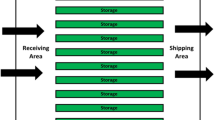Abstract
An automated negotiation mechanism for decentralized production coordination is presented and evaluated. The coordination problem contains a set of self-interested software agents, representing the production facilities of a supply chain, searching for a mutually agreeable production plan, while taking private information into account. The negotiation mechanism is applied and evaluated using a multi-facility production coordination problem, which is a reformulation of the well-known multi-level uncapacitated lot-sizing problem (MLULSP). The basic element of the mechanism is a decentralized simulated annealing method, consisting of a transition rule carried out by a neutral mediator agent and a cooperative acceptance rule carried out by negotiating agents. We use 176 benchmark problems from relevant literature for the evaluation. Experimental results show that the proposed negotiation mechanism comes close to those results which are obtained by centralized planning. Furthermore, the developed simulated annealing method applied in a single, centralized planning task is competitive with the best known solution methods for the MLULSP. It was possible to compute new best solutions for 24 of the benchmark problems.
Similar content being viewed by others
References
Aarts E, Korst J (1989) Simulated annealing and Boltzmann machines: a stochastic approach to combinatorial optimization and neural computing. Wiley, New York
Afentakis P, Gavish B (1986) Optimal lot-sizing algorithms for complex product structures. Oper Res 34(2): 237–249
Afentakis P, Gavish B, Karmarkar US (1984) Computationally efficient optimal solutions to the lot-sizing problem in multistage assembly systems. Manage Sci 30(2): 222–239
Agnetis A, Mirchandani PB, Pacciarelli D, Pacifici A (2004) Scheduling problems with two competing agents. Eur J Oper Res 52(2): 229–242
Albrecht M, Püttmann C, Scheckenbach B, Stadtler H, Braun H (2006) Recommendation for collaborative planning interface for service SC at the master planning level of an APS. Report 2.5, RWTH Aachen University. http://www.fir.rwth-aachen.de/projektseiten/incoco/files/DL_2_5.pdf. Accessed 28 Oct 2008
Arkin E, Joneja D, Roundy R (1989) Computational complexity of uncapacitated multi-echelon production planning problems. Oper Res Lett 8(2): 61–66
Benton WC, Srivastava R (1985) Product structure complexity and multilevel lot sizing using alternative costing policies. Decis Sci 16(4): 357–369
Bichler M, Kersten GE, Strecker S (2003) Towards a structured design of electronic negotiations. Group Decis Negot 12(4): 311–335
Bookbinder JH, Koch LA (1990) Production planning for mixed assembly/arborescent systems. J Oper Manage 9(1): 7–23
Cachon GP, Larivière M (2005) Supply chain coordination with revenue-sharing contracts: strengths and limitations. Manage Sci 51(1): 30–44
Černý V (1985) Thermodynamical approach to the traveling salesman problem: an efficient simulation algorithm. J Optim Theor Appl 45(1): 41–51
Christopher M (1998) Logistics and supply chain management—strategies for reducing cost and improving service, 2nd edn. Financial Times/Pitman, London
Chu C-L, Leon VJ (2008) Single-vendor multi-buyer inventory coordination under private information. Eur J Oper Res 191(2): 484–502
Clearwater SH (1996) Market-based control: a paradigm for distributed resource allocation. World Scientific, Singapore
Coleman BJ, McKnew MA (1991) An improved heuristic for multilevel lot sizing in material requirements planning. Decis Sci 22(1): 136–156
Dellaert NP, Jeunet J (2000) Solving large unconstrained multilevel lot-sizing problems using a hybrid genetic algorithm. Int J Prod Res 38(5): 1083–1099
Dellaert NP, Jeunet J (2003) Randomized multi-level lot-sizing heuristics for general product structures. Eur J Oper Res 148(1): 211–228
Dudek G (2004) Collaborative planning in supply chains: a negotiation-based approach. Lect Notes Econ Math Syst, vol 533. Springer, Berlin
Dudek G, Stadtler H (2005) Negotiation-based collaborative planning between supply chains partners. Eur J Oper Res 163(3): 668–687
Dudek G, Stadtler H (2007) Negotiation-based collaborative planning in divergent two-tier supply chains. Int J Prod Res 45(2): 465–484
Ertogral K, Wu SD (2000) Auction-theoretic coordination of production planning in the supply chain. IIE Trans 32(10): 931–940
Fandel G, Stammen-Hegener C (2006) Simultaneous lot sizing and scheduling for multi-product multi-level production. Int J Prod Econ 104(2): 308–316
Fink A (2004) Supply chain coordination by means of automated negotiations. In: Proceedings of the 37th Hawaii international conference on system sciences, Hawaii CD-ROM, p 10
Fink A (2006) Supply chain coordination by means of automated negotiation between autonomous agents. In: Chaib-draa B, Müller J (eds) Multiagent based supply chain management. Studies in Computational Intelligence, vol 28. Springer, Berlin, pp 351–372
Fink A (2007) Barwertorientierte Projektplanung mit mehreren Akteuren mittels eines verhandlungsbasierten Koordinationsmechanismus. In: Oberweis A, Weinhardt C, Gimpel H, Koschmider A, Pankratius V, Schnizler B (eds) eOrganisation: service-, prozess-, market-engineering, vol 2. Universitätsverlag, Karlsruhe, pp 465–482
Fujita K, Ito T, Hattori H, Klein M (2008) An approach to implementing a threshold adjusting mechanism in very complex negotiations: a preliminary result. Stud Comp Intell, vol 110. Springer, Berlin, pp 127–141
Gjerdrum J, Shah N, Papageorgiou LG (2001) Transfer prices for multienterprise supply chain optimization. Ind Eng Chem Res 40(7): 1650–1660
Homberger J (2008) A parallel genetic algorithm for the multi-level unconstrained lot-sizing problem. INFORMS J Comput 20(1): 124–132
Homberger J (2009) Decentralized multi-level unconstrained lot-sizing. http://www.dmlulsp.com/. Accessed 22 Jan 2009
Homberger J, Gehring H (2009) An ant colony optimization approach for the multi-level unconstrained lot-sizing problem. In: Proceedings of the 42nd Hawaii international conference on system sciences, Hawaii, CD-ROM, p 7
Ito T, Klein M, Hattori H (2007) Multi-issue negotiation protocol for agents: exploring nonlinear utility spaces. In: Proceedings of the 20th international joint conference on artificial intelligence, Hyderabad, India, pp 1347–1352
Jennings NR, Faratin P, Lomuscio AR, Parsons S, Woolridge M, Sierra C (2001) Automated negotiation: prospects, methods and challenges. Group Decis Negot 10(2): 199–215
Jennings NR, Parsons S, Sierra C, Faratin P (2000) Automated negotiation. In: Proceedings of the 5th international conference on the practical application of intelligent agents and multi-agent systems, Manchester, UK, pp 23–30
Jennings NR, Wooldridge M (1995) Applying agent technology. Appl Artif Intell 9(4): 357–369
Jones GT (2006) Hybrid computational models for the mediated negotiation of complex contracts. In: Proceedings of the 14th annual conference of the North American association for computational social and organization science, Notre Dame, Indiana. http://law.gsu.edu/gjones/pdfs/NAACSOS%20Complex%20Contracts.pdf. Accessed 22 Jan 2009
Jonker CM, Robu V (2004) Automated multi-attribute negotiation with efficient use of incomplete preference information. In: Proceedings of the 3rd international joint conference on autonomous agents and multi-agent systems, vol 3, New York, pp 1054–1061
Jung H, Chen FF, Jeong B (2005) A production-distribution coordinating model for third party logistics partnership. In: Proceedings of the 2005 IEEE international conference on automation science and engineering, Edmonton, Canada, pp 99–104
Kersten GE (2003) The science and engineering of e-negotiation: an introduction. In: Proceedings of the 36th Hawaii international conference on systems sciences, Hawaii, CD ROM, p 10
Kirkpatrick S, Gelatt CD Jr, Vecchi MP (1983) Optimization by simulated annealing. Science 220(4598): 671–680
Klein M, Faratin P, Bar-Yam Y (2002) Using an annealing mediator to solve the prisoners’ dilemma in the negotiation of complex contracts source. In: Padget J, Shehory O, Parkes D, Sadeh N, Walsh WE (eds) Agent-mediated electronic commerce IV. Lecture notes on artificial intelligence, vol 2531. Springer, Berlin, pp 194–202
Klein M, Faratin P, Sayama H, Bar-Yam Y (2003a) Negotiating complex contracts. Group Decis Negot 12(2): 111–125
Klein M, Faratin P, Sayama H, Bar-Yam Y (2003b) Protocols for negotiating complex contracts. IEEE Intell Syst 18(6): 32–38
Klein M, Faratin P, Sayama H, Bar-Yam Y (2003c) Negotiation algorithms for collaborative design settings. In: Proceedings of the 10th ISPE international conference on concurrent engineering research and applications, Madeira, pp 161–167
Kuik R, Salomon M (1990) Multi-level lot-sizing problem: evaluation of a simulated-annealing heuristic. Eur J Oper Res 45(1): 25–37
van Laarhoven PMJ, Aarts EHL (1987) Simulated annealing: theory and applications. Kluwer, Dordrecht
Lau JSK, Huang GQ, Mak KL, Liang L (2005) Distributed project scheduling with information sharing in supply chains: part II–theoretical analysis and computational study. Int J Prod Res 43(23): 4899–4927
Lomuscio AR, Wooldridge M, Jennings NR (2003) A classification scheme for negotiation in electronic commerce. Group Decis Negot 12(1): 31–56
Pitakaso R, Almeder C, Doerner KF, Hartl RF (2007) A MAX–MIN ant system for unconstrained multi-level lot-sizing problems. Comput Oper Res 34(9): 2533–2552
Salomon M, Kuik R (1993) Statistical search methods for lotsizing problems. Ann Oper Res 41(1–4): 453–468
Sandholm T (2003) Automated mechanism design: a new application area for search algorithms. In: Proceedings of the international conference on principles and practice of constraint programming, Kinsale, Ireland, pp 19–32
Steinberg E, Napier HA (1980) Optimal multi-level lot sizing for requirements planning systems. Manage Sci 26(12): 1258–1271
Steinhöfel K, Albrecht AA, Wong C-K (2000) Convergence analysis of simulated annealing-based algorithms solving flow shop scheduling problems. In: Goos G, Hartmanis J, van Leeuwen J (eds) Algorithms and complexity. Lecture notes on computer science, vol 1767. Springer, Berlin, pp 277–290
Straube F, Beyer I (2006) Decentralized planning in global and local networks—coordination of inter- and intraorganizational networks at tactical level. In: Proceedings of the IFSAM VIIIth world congress 2006, Berlin, Germany, pp 1–7
Ströbel M, Weinhardt C (2003) The montreal taxonomy for electronic negotiations. Group Decis Negot 12(2): 143–164
Veral EA, LaForge RL (1985) The performance of a simple incremental lot-sizing rule in a multilevel inventory environment. Decis Sci 16(1): 57–72
Voß S, Woodruff DL (2006) Introduction to computational optimization models for production planning in a supply chain, 2nd edn. Springer, Berlin
Walsh WE, Wellman MP, Wurman PR, MacKie-Mason JK (1998) Some economics of market-based distributed scheduling. In: Proceedings of the 18th international conference on distributed computing systems, Amsterdam, The Netherlands, pp 612–621
Yelle LE (1979) Materials requirements lot sizing: a multilevel approach. Int J Prod Res 17(3): 223–232
Zimmer K (2004) Hierarchical coordination mechanisms within the supply chain. Eur J Oper Res 153(3): 687–703
Author information
Authors and Affiliations
Corresponding author
Rights and permissions
About this article
Cite this article
Homberger, J. Decentralized multi-level uncapacitated lot-sizing by automated negotiation. 4OR-Q J Oper Res 8, 155–180 (2010). https://doi.org/10.1007/s10288-009-0104-1
Received:
Revised:
Published:
Issue Date:
DOI: https://doi.org/10.1007/s10288-009-0104-1




